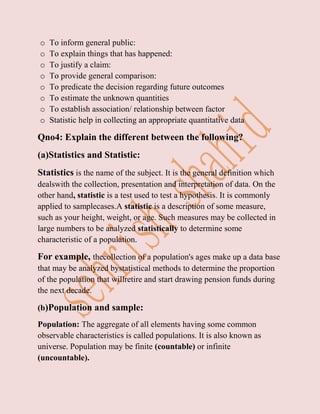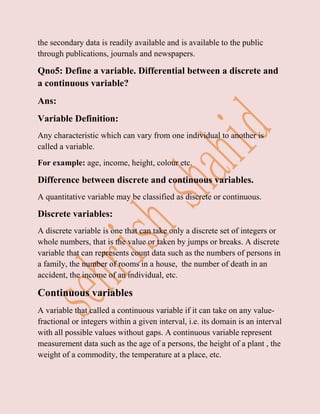intro to statistics
- 1. Assignment: Introduction to statistical theory Name: Sehrish Shahid Roll no: 13024854-1115 Department: Commerce and Accountancy
- 2. Introduction to statistical theory Chapter#1: Introduction Exercise: Subjective Qno1: Explain what is meant by statistic. Give the important uses and limitation of statistic? Ans: ’éĘ Meaning of statistic: The word ŌĆśŌĆÖStatisticŌĆÖŌĆÖderived from Latinword status, meaning a political state, originally meant information useful to the state, for example, information about the size of populations and armed forces. The word statistic is defined in three different ways: 1. Statistic as a science. 2. Statistic as the collection of numerical facts. 3. Statistic plural of statistic. ’éĘ Important uses of statistic Statistic can be used for variety of reason. Some of them are: o To inform general public: o To explain things that has happened: o To justify a claim: o To provide general comparison: o To predicate the decision regarding future outcomes o To estimate the unknown quantities o To establish association/ relationship between factor
- 3. o Statistic help in collecting an appropriate quantitative data ’éĘ Limitation of statistic Statistic has wide application in almost every sphere of human activity. But it has the following information and limitations. o Statistic laws are not so perfect as the law of physic and chemistry. o Statistic does not study individual item as statistic. o Statistic results are truly only on average. Qno2: Define statistic .Discuss, giving example, the importance of the study of statistics and show how it can help e the extension of scientific knowledge? Ans: Definition of statistic: Statistic is the science which deals with the collection presentation, analyzations and interpretation of numerical data. In the first place: The words statistics refers to ŌĆ£numerical facts systematically arrangedŌĆØ. In this sense the word statistics is always used in the plural .we have for instance statistics of price, statistics of road accident, statistics of crimes, birth educational institutions etc. in all these examples the word statistics denotes a set of numerical data in the respective fields. Qno3: (a) Define statistic and explain its characteristic? Ans:
- 4. Definition of statistic: Statistic is the science which deals with the collection presentation, analyzations and interpretation of numerical data. Characteristics of statistic: In order to understand the nature and suitability of statistic, its important characteristics are given as: o Statistics are the aggregate of facts and figures. o Statistics are numerically expressed o Statistic laws are valid in the long run. o Statistic must be comparable to each other. o Statistics are collected in systematic manner. o Statistics are collected for a pre-determined purpose. Qno3: (b) what are the uses of statistic? Ans: Uses of statistics: o To inform general public: o To explain things that has happened: o To justify a claim: o To provide general comparison: o To predicate the decision regarding future outcomes o To estimate the unknown quantities o To establish association/ relationship between factor o Statistic help in collecting an appropriate quantitative data Statistic can be used for variety of reason. Some of them are:
- 5. o To inform general public: o To explain things that has happened: o To justify a claim: o To provide general comparison: o To predicate the decision regarding future outcomes o To estimate the unknown quantities o To establish association/ relationship between factor o Statistic help in collecting an appropriate quantitative data Qno4: Explain the different between the following? (a)Statistics and Statistic: Statistics is the name of the subject. It is the general definition which dealswith the collection, presentation and interpretation of data. On the other hand, statistic is a test used to test a hypothesis. It is commonly applied to samplecases.A statistic is a description of some measure, such as your height, weight, or age. Such measures may be collected in large numbers to be analyzed statistically to determine some characteristic of a population. For example, thecollection of a population's ages make up a data base that may be analyzed bystatistical methods to determine the proportion of the population that willretire and start drawing pension funds during the next decade. (b)Population and sample: Population: The aggregate of all elements having some common observable characteristics is called populations. It is also known as universe. Population may be finite (countable) or infinite (uncountable).
- 6. Sample: Any subgroup of the population selected for study is called sample. (c)Descriptive and inferential statistics. Descriptive statistics: Descriptive statisticsdeals tosummarize organize and analyze the statistical data in order to describe the various features. Inferential statistics: Inferential statistics is based own those methods which deal with drawings inferences about population on the basis of sample information. (d) Quantitative and Qualitative variables: Quantitative variable:Quantitative variable is a characteristic which can be expressed numerically such as height, weight, family size etc. Qualitative variable:Qualitative variable is a characteristic which can only be expressed in quality such as honesty, beauty, happiness etc. (e)Discrete and continuous variables. A quantitative variable may be classified as discrete or continuous. Discretevariables: A discrete variable is one that can take only a discrete set of integers or whole numbers, that is the value or taken by jumps or breaks. A discrete variable that can represents count data such as the numbers of persons in a family, the number of rooms in a house, the number of death in an accident, the income of an individual,etc. Continuous variables
- 7. A variable that called a continuous variable if it can take on any value- fractional or integers-within a given interval, i.e. its domain is an interval with all possible values without gaps. A continuous variable represent measurement data such as the age of a persons, the height of a plant , the weight of a commodity, the temperature at a place, etc. (f) Biased and unbiased errors: Biased errors: An error is said to be biased when the observed value is consistently and constantly higher or lower than the true value. Biased errors arise from the personal limitations of the observer, the imperfection in the instruments used or some other conditions which control the measurements. These errors are not revealed by repeating the measurements. They are cumulative in nature, that is, the greater the number of measurements, the greater would be the magnitude of error. They are thus more troublesome. These errors are also called cumulative or systematic errors. Unbiased errors: An errors on the other hand is said to be unbiased when the deviations, i.e. the excesses and defects, from the true value tend to occur equally often. Unbiased errors are revealed when measurements are repeated and then tend to cancel out in the long run. These errors are therefore compensating and are also known as random errors or accidental errors. (g)Primary data and secondary data: The difference between primary and secondary data is that Primary data is collected firsthand by a researcher through experiments, surveys, questionnaires, focus groups, interviews and taking measurements, while
- 8. the secondary data is readily available and is available to the public through publications, journals and newspapers. Qno5: Define a variable. Differential between a discrete and a continuous variable? Ans: Variable Definition: Any characteristic which can vary from one individual to another is called a variable. For example: age, income, height, colour etc. Difference between discrete and continuous variables. A quantitative variable may be classified as discrete or continuous. Discrete variables: A discrete variable is one that can take only a discrete set of integers or whole numbers, that is the value or taken by jumps or breaks. A discrete variable that can represents count data such as the numbers of persons in a family, the number of rooms in a house, the number of death in an accident, the income of an individual, etc. Continuous variables A variable that called a continuous variable if it can take on any value- fractional or integers within a given interval, i.e. its domain is an interval with all possible values without gaps. A continuous variable represent measurement data such as the age of a persons, the height of a plant , the weight of a commodity, the temperature at a place, etc.
- 9. Qno5 :( b) Classify the following variable as discreet or continues variable? I) The number of students attending a class. Discreet variable II) The amount of milk produced by a cow. Continues variable III) The numbers of heads in the toss of 6 coins. Discreet variable IV) The yearly income of a college professor. Discreet variable V) The age of a shopkeeper. Continues variable Qno6: Classify each variable as qualitative or quantitative. i) Colour of eyes Qualitative variable ii) Numbers of computers sold in the last month. Quantities variable iii) Material status of faculty members. Qualitative variable iv) StudentŌĆÖs weight. Quantities variable v) Lifetimes of car batteries. Qualitative variable vi) Number of burgers sold by a fast food shop. Quantities variable vii) Brand of cars Quantities variable
- 10. Qno7: Classify each as nominal ŌĆōlevel, ordinal level, internal level or ratio-level measurement. I) Weight of car Ratio II) Ranking of squash player Ordinal III) Temperature of city Interval IV) Salaries of top five executives in bank Ratio V) Marital status Nominal Qno8: Round off the following continuous data to four significant digits each. I) 32.21705 Round of four significant digits become 32.22. II) 937.0500 Four significant become 937.1 because we increase zero proceeds 5 by 1 as 5. III) 0.003599499 Rounded four become 0.0003599 because beginning zero are not significant. IV) 1.003599499 Rounded four significant digit become 1.004. V) 0.07000455 Rounded four significant digits become 0.07000.
- 11. Qno9: a) Distinguish between primary and secondary data, giving example of each? Ans: ŌĆ£Primary dataŌĆØ Data have been originally collected (raw data) and have not undergone any sort of statistical treatment, are called primary data. While data have been undergone any sort of treatment by statistical treatment by statistical method at least once, i.e. ŌĆ£Secondary dataŌĆØ The data have been collected classified, tabulated or presented in some .form for a certain purpose, are called secondary data. (a) To define the objective of the survey. (b) To define the variable (s) and the population of the interest. b) Describe the method which can be used in the collection of statistical data, stating the advantages of each method. Ans: This method may prove very costly and time consuming when the area to be covered is vast. Errors are lightly to enter the result due to personal bias of the invesliger. ’āś Indirect investigation: The method is useful when the information desired is complex or there is reluctance or indifference on the part of the informationŌĆÖs.
- 12. As some of the informants are likely to deliberately give wrong informationŌĆÖs. So the reliance is not placed on the evidence of one witness only. ’āś Collection through local sources: This method is cheap and expeditions. This is cheap but gives only the estimates. ’āś Collection through EnumeratorsŌĆÖ: This method gives the most reliable informationŌĆÖs if the enumerator is well trained. This method canŌĆÖt be adopted by private individual or institutions as its costs would be prohibitive. ’āś Collection through Questionnaire: This method is considered as the standard method for routine business and administrates inquire. The method is cheap fairly expeditions and good for extensive inquires.













